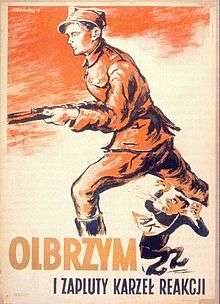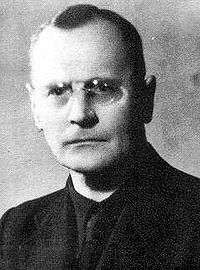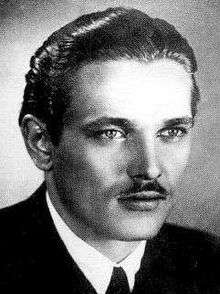Cursed soldiers
| The cursed soldiers | |
|---|---|
| Żołnierze wyklęci | |
|
'Disavowed soldiers' of the anti-communist underground. Left to right (June 1947):
| |
| Active | 1944 – 1963 |
| Country | Poland |
| Allegiance | Polish Government-in-Exile |
| Role | Armed forces of the Polish Underground State and the Polish Government-in-Exile |
| Size | 53,000 |
The "cursed soldiers"[1] (also known as "disavowed soldiers", "accursed soldiers" or "damned soldiers"; Polish: Żołnierze wyklęci) is a term applied to a variety of anti-communist Polish resistance movements formed in the later stages of World War II and its aftermath by some members of the Polish Underground State. These clandestine organisations continued their armed struggle against the Stalinist government of Poland well into the 1950s. The guerrilla warfare included an array of military attacks launched against the communist regime's prisons and state security offices, detention facilities for political prisoners and concentration camps that were set up across the country. Most of the Polish anti-communist groups ceased to exist in the late 1940s or 1950s, hunted down by agents of the Ministry of Public Security and Soviet NKVD assassination squads.[2] However, the last known 'cursed soldier', Józef Franczak, was killed in an ambush as late as 1963, almost 20 years after the Soviet take-over of Poland.[3][4]
The best-known Polish anti-communist resistance organisations operating in Stalinist Poland included Freedom and Independence (Wolność i Niezawisłość, WIN), National Armed Forces (Narodowe Siły Zbrojne, NSZ), National Military Union (Narodowe Zjednoczenie Wojskowe, NZW), Konspiracyjne Wojsko Polskie (Underground Polish Army, KWP), Ruch Oporu Armii Krajowej (Home Army Resistance, ROAK), Armia Krajowa Obywatelska (Citizens' Home Army, AKO), NIE (NO, short for Niepodległość), Armed Forces Delegation for Poland (Delegatura Sił Zbrojnych na Kraj), and Wolność i Sprawiedliwość (Freedom and Justice, WiS).[4]
Similar Eastern European anti-communists fought on in other countries that were occupied by the Soviet Union.
Historical background

In the summer of 1944, as Soviet forces fighting against Nazi Germany advanced into Poland, the USSR set up a provisional puppet government of Poland called the Polish Committee of National Liberation. The new regime was aware that the Polish Resistance (whose chief component was the Armia Krajowa or Home Army) and Underground State loyal to the Polish government-in-exile would have to be destroyed before they could gain complete control over Poland.[5] Future General Secretary of the Polish United Workers' Party Władysław Gomułka pronounced that "Soldiers of the Armia Krajowa (AK) are a hostile element which must be removed without mercy". Another prominent communist, Roman Zambrowski, said that the AK had to be "exterminated".[6]
The Armia Krajowa officially disbanded on 19 January 1945 to prevent a slide into armed conflict with the Red Army and the increasing threat of civil war over Poland's sovereignty. However, many resistance units decided to continue with their struggle for Polish independence, regarding Soviet forces as new occupiers. Soviet partisans in Poland had already been ordered by Moscow on 22 June 1943 to engage Polish Leśni partisans in combat.[7] They commonly fought against the Polish resistance more often than against the Germans.[5] The main forces of the Red Army (Northern Group of Forces) and the NKVD began conducting operations against the Armia Krajowa during and directly after the launch of Operation Tempest, the aim of which was for the Polish resistance to seize control of cities and areas occupied by the Germans while they were preparing their defenses against the advancing Soviets.[6] The Soviet leader Joseph Stalin aimed to ensure that an independent Poland would never reemerge in the postwar period.[8]
Formation of the anti-communist underground
The first AK structure designed primarily to deal with the Soviet threat was NIE (short for niepodległość "independence", and also meaning "no"), formed in mid-1943. NIE's goal was not to engage Soviet forces in combat, but rather to observe and conduct espionage while the Polish government-in-exile decided how to deal with the Soviets. At that time, the exiled government still believed that a solution leading to Poland's post-war independence could be found through negotiations.
On 7 May 1945, NIE was disbanded and transformed into the Delegatura Sił Zbrojnych na Kraj ("Armed Forces Delegation for Homeland"). However, this organization lasted only until 8 August 8, 1945, when the decision was made to disband it and to stop partisan resistance on Polish territory.[6]
In March 1945 a staged trial of 16 leaders of the Polish Underground State, who had been captured and imprisoned by the Soviet Union took place in Moscow (the Trial of the Sixteen).[9][10][11][12] The Government Delegate, together with most members of the Council of National Unity and the Commander-in-Chief of the Armia Krajowa, were invited by Soviet general Ivan Serov, with the agreement of Joseph Stalin, to a conference on their eventual entry into the Soviet-backed Provisional Government. They were presented with a warrant of safety, but the NKVD arrested them in Pruszków on 27 and 28 March.[13][14] Leopold Okulicki, Jan Stanisław Jankowski and Kazimierz Pużak were arrested on the 27th and 12 more the following day. Alexander Zwierzynski had already been detained earlier. They were all taken to the Lubyanka prison in Moscow for interrogation prior to the trial.[15][16][17] After several months of brutal interrogation and torture[18] they were charged with false accusations of "collaboration with Nazi Germany" and of "planning a military alliance with Nazi Germany".[19][20]
The Polish Committee of National Liberation declined jurisdiction over former AK soldiers. Consequently, for more than a year, it was Soviet agencies like the NKVD that dealt with the AK. By the end of the war, approximately 60,000 soldiers of the AK had been arrested, and 50,000 of them were deported to the Soviet Union's prisons and prison camps. Most of those soldiers had been captured by the Soviets during or in the aftermath of Operation Tempest, when many AK units tried to cooperate with the Red Army during their nationwide uprising against the Germans.
Other veterans were arrested when they decided to approach the communist authorities after being promised amnesty. In 1947, the government of the People's Republic of Poland proclaimed an amnesty for most of the wartime resistance fighters. The authorities expected around 12,000 people to give up their arms, but the actual number of partisans to come out of the forests eventually reached 53,000. Many of them were arrested despite promises of freedom; and after repeated broken promises during the first few years of communist rule, former AK members refused to trust the government.[6]
After the Delegatura Sił Zbrojnych na Kraj ("Armed Forces Delegation for Homeland") was disbanded, another post-AK resistance organisation was formed, called Wolność i Niezawisłość ("Freedom and Sovereignty"). Its primary goal was not combat - Wolność i Niezawisłość (WiN) was more concerned with helping former AK soldiers make the transition from a life as partisans to that of civilians. Continued secrecy and conspiracy were necessary in light of the increasing persecution of AK veterans by the communist government. WiN was, however, much in need of funds to pay for false documents and to provide resources for the partisans, many of whom had lost their homes and entire life-savings in the war. Viewed as enemies of the state, starved of resources, and with a vocal faction advocating armed resistance against the Soviets and their Polish proxies, WiN was far from efficient. A significant victory for the NKVD and the newly created Polish secret police, Urząd Bezpieczeństwa (UB), came in the second half of 1945, when they managed to convince several leaders of WiN that they truly wanted to offer amnesty to AK members. Within a few months, intelligence gathered by the authorities led to thousands more arrests.[6] The primary period of WiN activity lasted until 1947. The organisation finally disbanded in 1952.[21]
Persecution

The NKVD and UB used brute force and deception to eliminate the underground opposition. In the autumn of 1946, a group of 100–200 accursed soldiers of Narodowe Siły Zbrojne (National Armed Forces, NSZ) were lured into a trap and massacred. In 1947, Colonel Julia ("Bloody Luna") Brystiger of the Polish Ministry of Public Security proclaimed at a security briefing that: "[t]he terrorist and political underground" had ceased to be a threatening force for the UB, although the "class enemy" at universities, offices and factories still had to be "found out and neutralised."[6]
The persecution of AK members was only one aspect of the reign of Stalinist terror in postwar Poland. In the period from 1944 to 1956, at least 300,000 Polish civilians were arrested,[22] although some sources claim numbers up to two million.[6] Approximately 6,000 death sentences were issued, and the majority of them were carried out.[22] It is probable that over 20,000 people died in communist prisons including those executed "in the majesty of the law" such as Witold Pilecki, a hero of Auschwitz.[6]
A further six million Polish citizens (i.e., one out of every three adult Poles) were classified as suspected members of a 'reactionary or criminal element' and subjected to investigation by state agencies. During the Polish October of 1956, a political amnesty freed 35,000 former AK soldiers from prisons. Nevertheless, some partisans remained in service, unwilling or simply unable to rejoin the civilian community. The cursed soldier Stanisław Marchewka "Ryba" ("The Fish") was killed in 1957, and the last AK partisan, Józef Franczak "Lalek" ("Doller"), was killed in 1963 — almost two decades after the Second World War ended. Four years later, long after the abolition of Stalinist terror, the last member of the elite British-trained Cichociemny ("The Silent and Hidden") intelligence and support group, Adam Boryczka was finally released from prison (1967). Until the end of the People's Republic of Poland, former AK soldiers were under constant investigation by the secret police. It was only in 1989, after the fall of communism, that the convictions of AK soldiers were finally declared invalid and annulled by Polish law.[6]
The largest operations and actions
The biggest battle in the history of the National Military Union (Narodowe Zjednoczenie Wojskowe, NZW) took place on 6–7 May 1945, in the village of Kuryłówka in southeastern Poland. The Battle of Kuryłówka fought against the Soviet 2nd Border Regiment of the NKVD, ended in a victory for the underground forces commanded by Major Franciszek Przysiężniak ("Marek"). The anti-communist fighters killed up to 70 Soviet agents. The NKVD troops retreated in haste, only to reappear in the village later on and burn it to the ground in retaliation, destroying over 730 buildings.[23][24]
On 21 May 1945, a heavily armed AK unit led by Colonel Edward Wasilewski, attacked and destroyed the NKVD camp located in Rembertów on the eastern outskirts of Warsaw. The Soviets had incarcerated hundreds of Polish citizens there,[25][26][27] including members of the Armia Krajowa.[28]
Pacification
One of the biggest anti-partisan operations by the communist authorities took place from 10–25 June 1945, in and around the Suwałki and Augustów regions of Poland. The "Augustów roundup" (Polish: Obława augustowska) was a joint operation of the Red Army, the Soviet NKVD, and SMERSH battalions with assistance from Polish UB and LWP units, against Armia Krajowa resistance fighters. The operation extended into the territory of occupied Lithuania. More than 2,000 suspected anti-communist Polish fighters were captured and detained in Soviet internment camps. About 600 of the "Augustow Missing" are presumed to have died in Soviet custody, their bodies buried in unknown mass graves on the present territory of Russia. The Polish Institute of National Remembrance has declared the 1945 Augustów roundup to be "the largest crime committed by the Soviets on Polish lands after World War II."[29]
Anti-communist resistance organizations
Among the best-known Polish underground organizations,[4] engaged in guerrilla warfare were:
- Wolność i Niezawisłość ("Freedom and Independence", WIN) founded on September 2, 1945, active to 1952.
- Narodowe Siły Zbrojne ("National Armed Forces", NSZ) created on September 20, 1942, split in March 1944.
- Narodowe Zjednoczenie Wojskowe ("National Military Union", NZW) established in mid-to-late 1940s, active until mid-1950s.
- Konspiracyjne Wojsko Polskie ("Underground Polish Army", KWP) which existed from April 1945 to as late as 1954.
- Ruch Oporu Armii Krajowej ("Resistance of the Home Army", ROAK) formed in 1944 against UB collaborators.
- Armia Krajowa Obywatelska ("Citizens' Home Army", AKO) founded in February 1945, incorporated into Wolność i Niezawisłość in 1945.
- NIE ("NO") formed in 1943, active till 7 May 1945.
- Delegatura Sił Zbrojnych na Kraj ("Delegature of the Polish Forces at Home") formed on May 7, 1945, dissolved on August 8, 1945.
- Wolność i Sprawiedliwość ("Freedom and Justice", WIS) founded in early 1950s.
Events
- Battle of Kuryłówka
- Augustów roundup (Polish: Obława augustowska)
- Attack on the NKVD Camp in Rembertów
- 1951 Mokotow Prison execution
- Raid on Kielce Prison
Notable members
|
Witold Pilecki ("Witold")  Marian Bernaciak ("Orlik")  Lt. Józef Kuraś ("Ogień" -- "fire")  Danuta Siedzikówna, pseudonym "Inka" Władysław Łukasiuk ("Hammer") |
In popular culture
The novel Ashes and Diamonds by Jerzy Andrzejewski and Andrzej Wajda's film of the book, depict events in Poland in the immediate aftermath of the Second World War, including an operation by anti-communist resistance fighters to assassinate a commissar.
See also
References
- ↑ The Communist Century: From Revolution To Decay: 1917 to 2000 By Chris Kostov, pp. 66-.
- ↑ Tennent H. Bagley (2007). Spy wars: moles, mysteries, and deadly games. Yale University Press. p. 120. ISBN 0-300-12198-9. Retrieved May 24, 2011.
- ↑ "Żołnierze wyklęci: Antykomunistyczne podziemie po 1945 roku". Muzeum Podkarpackie, Krosno. 2007. Archived from the original on May 3, 2007. Retrieved May 29, 2011.
w 50 lat po zamordowaniu członków IV Zarządu Głównego Zrzeszenia Wolność i Niezawisłość
(Polish) - 1 2 3 Agnieszka Adamiak, Oddziałowe Biuro Edukacji Publicznej (2001). "Żołnierze wyklęci. Antykomunistyczne podziemie na Rzeszowszczyźnie po1944 roku". Institute of National Remembrance. Retrieved May 29, 2011. (Polish)
- 1 2 Review of Sowjetische Partisanen in Weißrußland, by Marek Jan Chodakiewicz, in Sarmatian Review, April 2006.
- 1 2 3 4 5 6 7 8 9 Andrzej Kaczyński (2 October 2004), Wielkie polowanie: Prześladowania akowców w Polsce Ludowej [Great hunt: the persecutions of AK soldiers in the People's Republic of Poland], Rzeczpospolita, Nr 232, last accessed 21 March 2016 via Internet Archive.
- ↑ Tadeusz Piotrowski, Poland's Holocaust, McFarland & Company, 1997, ISBN 0-7864-0371-3. Google Print, pp. 88, 89, 90.
- ↑ Judith Olsak-Glass, Review of Piotrowski's Poland's Holocaust in Sarmatian Review, January 1999.
- ↑ Prazmowska, A. (2004) Civil war in Poland, 1942-1948 Palgrave ISBN 0-333-98212-6 Page 115
- ↑ Malcher, G.C. (1993) Blank Pages Pyrford Press ISBN 1-897984-00-6 Page 73
- ↑ Mikolajczyk, S. (1948) The pattern of Soviet domination Sampson Low, Marston & Co Page 125
- ↑ Garlinski, J.(1985) Poland in the Second World War Macmillan ISBN 0-333-39258-2 Page 324
- ↑ Prazmowska, A. (2004) Civil war in Poland, 1942-1948 Palgrave ISBN 0-333-98212-6 Page 116
- ↑ Michta, A. (1990) Red Eagle Stanford University ISBN 0-8179-8862-9 Page 39
- ↑ Garlinski, J.(1985) Poland in the Second World War Macmillan ISBN 0-333-39258-2 Page 325-326
- ↑ Umiastowski, R. (1946) Poland, Russia and Great Britain 1941-1945 Hollis & Carter Pages 462-464
- ↑ Piesakowski, T. (1990) The fate of Poles in the USSR 1939~1989 Gryf Pages 198-199
- ↑ Garlinski, J.(1985) Poland in the Second World War Macmillan ISBN 0-333-39258-2 Page 335
- ↑ Garlinski, J.(1985) Poland in the Second World War Macmillan ISBN 0-333-39258-2 Page 336
- ↑ Umiastowski, R. (1946) Poland, Russia and Great Britain 1941-1945 Hollis & Carter Pages 467-468
- ↑ Henryk Piecuch (1996). Akcje specjalne: od Bieruta do Ochaba. Wydawn. "69". p. 116. ISBN 978-83-86244-05-8. Retrieved 4 May 2012.
- 1 2 "Otwarcie wystawy "Zbrodnie w majestacie prawa 1944–1956" – Kraków, 2 lutego 2006". Instytut Pamięci Narodowej. Archived from the original on September 30, 2012. Retrieved June 1, 2011.
- ↑ Urząd Gminy Kuryłówka. "Kuryłówka village. Calendarium". Portal Podkarpacki. Retrieved May 30, 2011.
- ↑ Norman Davies, No Simple Victory, Viking Penguin, 2006.
- ↑ Norman Davies, Rising '44, 2004, Viking Penguin, ISBN 0-670-03284-0, p. 495
- ↑ Norman Davies, Rising '44, 2003, Macmillan, ISBN 0-333-90568-7, p. 495
- ↑ Norman Davies, Rising '44, 2004, Pan, ISBN 0-330-48863-5, p. 497
- ↑ Tadeusz Piotrowski, Poland's Holocaust: Ethnic Strife, Collaboration with Occupying Forces and Genocide in the Second Republic, 1918-1947, McFarland & Company, 1998, ISBN 0-7864-0371-3, p.131 (Google Print)
- ↑ "Konferencja IPN: "60. rocznica obławy augustowskiej." (IPN Conference on the 60th Anniversary of the Augustów roundup)". Instytut Pamięci Narodowej. 20 July 2005. Archived from the original on July 22, 2011. Retrieved May 30, 2011. (Polish)
- ↑ http://www.doomedsoldiers.com/not-only-katyn-the-roundup-begins.html
- ↑ http://www.doomedsoldiers.com/not-only-katyn-the-augustow-missing.html
- ↑ http://www.stankiewicze.com/index.php/index.php?kat=32&sub=1015
Further reading
- Jerzy Ślaski, Żołnierze wyklęci, Warszawa, Oficyna Wydawnicza Rytm, 1996
- Grzegorz Wąsowski and Leszek Żebrowski, eds., Żołnierze wyklęci: Antykomunistyczne podziemie zbrojne po 1944 roku, Warszawa, Oficyna Wydawnicza Volumen and Liga Republikańska, 1999
- Kazimierz Krajewski et al., Żołnierze wyklęci: Antykomunistyczne podziemie zbrojne po 1944 r., Oficyna Wydawnicza Volumen and Liga Republikańska, 2002
- Tomasz Łabuszewski, Białostocki Okręg AK- AKO : VII 1944-VIII 1945 (Warszawa: Oficzna Wydawnicza Volumen and Dom Wydawniczy Bellona, 1997)
- Zrzeszenie “Wolność i Niezawisłość” w dokumentach, 6 vols. (Wrocław: Zarząd Główny WiN, 1997–2001)
- Zygmunt Woźniczka, Zrzeszenie “Wolność i Niezawisłość” 1945-1952 (Warszawa: Instytut Prasy i Wydawnictw “Novum” – “Semex”, 1992)
- Marek Latyński, Nie paść na kolana: Szkice o opozycji lat czterdziestych (London: Polonia Book Fund Ltd., 1985)
External links
- (English) Short description of an exhibition on Łupaszko
- (English) The Doomed soldiers - Polish Underground Soldiers 1944-1963 - The Untold Story
- (English) WiN | Freedom and Independence - Historical Brief.
- (English) NSZ | National Armed Forces - Historical Brief.
- (Polish) Broader description
- (Polish) ŻOŁNIERZE WYKLĘCI NA KRESACH POŁUDNIOWO-WSCHODNICH PO 1944 R.
- (Polish) Antykomunistyczne Podziemie Zbrojne po 1944 roku
- (Polish) Żołnierze wyklęci
.jpg)



